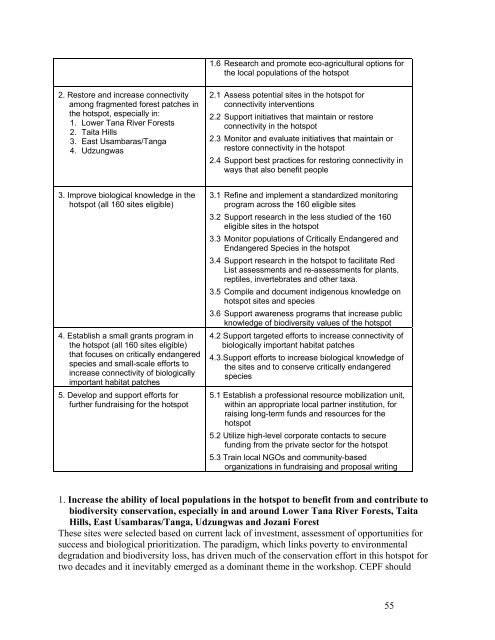Eastern Arc Mountains and Coastal Forests of Tanzania and Kenya ...
Eastern Arc Mountains and Coastal Forests of Tanzania and Kenya ...
Eastern Arc Mountains and Coastal Forests of Tanzania and Kenya ...
You also want an ePaper? Increase the reach of your titles
YUMPU automatically turns print PDFs into web optimized ePapers that Google loves.
1.6 Research <strong>and</strong> promote eco-agricultural options forthe local populations <strong>of</strong> the hotspot2. Restore <strong>and</strong> increase connectivityamong fragmented forest patches inthe hotspot, especially in:1. Lower Tana River <strong>Forests</strong>2. Taita Hills3. East Usambaras/Tanga4. Udzungwas2.1 Assess potential sites in the hotspot forconnectivity interventions2.2 Support initiatives that maintain or restoreconnectivity in the hotspot2.3 Monitor <strong>and</strong> evaluate initiatives that maintain orrestore connectivity in the hotspot2.4 Support best practices for restoring connectivity inways that also benefit people3. Improve biological knowledge in thehotspot (all 160 sites eligible)4. Establish a small grants program inthe hotspot (all 160 sites eligible)that focuses on critically endangeredspecies <strong>and</strong> small-scale efforts toincrease connectivity <strong>of</strong> biologicallyimportant habitat patches5. Develop <strong>and</strong> support efforts forfurther fundraising for the hotspot3.1 Refine <strong>and</strong> implement a st<strong>and</strong>ardized monitoringprogram across the 160 eligible sites3.2 Support research in the less studied <strong>of</strong> the 160eligible sites in the hotspot3.3 Monitor populations <strong>of</strong> Critically Endangered <strong>and</strong>Endangered Species in the hotspot3.4 Support research in the hotspot to facilitate RedList assessments <strong>and</strong> re-assessments for plants,reptiles, invertebrates <strong>and</strong> other taxa.3.5 Compile <strong>and</strong> document indigenous knowledge onhotspot sites <strong>and</strong> species3.6 Support awareness programs that increase publicknowledge <strong>of</strong> biodiversity values <strong>of</strong> the hotspot4.2 Support targeted efforts to increase connectivity <strong>of</strong>biologically important habitat patches4.3.Support efforts to increase biological knowledge <strong>of</strong>the sites <strong>and</strong> to conserve critically endangeredspecies5.1 Establish a pr<strong>of</strong>essional resource mobilization unit,within an appropriate local partner institution, forraising long-term funds <strong>and</strong> resources for thehotspot5.2 Utilize high-level corporate contacts to securefunding from the private sector for the hotspot5.3 Train local NGOs <strong>and</strong> community-basedorganizations in fundraising <strong>and</strong> proposal writing1. Increase the ability <strong>of</strong> local populations in the hotspot to benefit from <strong>and</strong> contribute tobiodiversity conservation, especially in <strong>and</strong> around Lower Tana River <strong>Forests</strong>, TaitaHills, East Usambaras/Tanga, Udzungwas <strong>and</strong> Jozani ForestThese sites were selected based on current lack <strong>of</strong> investment, assessment <strong>of</strong> opportunities forsuccess <strong>and</strong> biological prioritization. The paradigm, which links poverty to environmentaldegradation <strong>and</strong> biodiversity loss, has driven much <strong>of</strong> the conservation effort in this hotspot fortwo decades <strong>and</strong> it inevitably emerged as a dominant theme in the workshop. CEPF should55
















